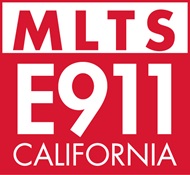E911 Multi-Line Telephone System Requirements for Service Providers

Customer Education and Tariff Requirements
In 2013, the Commission passed Decision (D.)13-07-019 to improve public safety in California by improving access to the Enhanced 911 (E911) Multi-line Telephone System (MLTS). Local exchange carriers were directed to revise their local access tariff language to inform customers (e.g., building owners and MLTS equipment manufacturers) about provisioning accurate 9-1-1 caller MLTS location information and their responsibility to maintain the 9-1-1 database.
Carriers were also required to distribute a PBX 911 Advisory Brochure to raise customer awareness of critical MLTS communications safety issues affecting California’s large businesses and other facilities in order to:
- Reduce the time for emergency responders to locate 9-1-1 callers within extensive building complexes such as workplaces, hotels, and school campuses as well as residences such as mobile homes served by a Shared Tenant Service; and
- Minimize the amount of time that first responders are exposed to dangerous conditions.
Additional MLTS Information
The California Public Utilities Commission (CPUC) also coordinates with the California Office of Emergency Services (Cal OES) to improve the provision of emergency access to 9-1-1 from any communications device. Cal OES published a fact sheet with guidance for MLTS providers including recent federal MLTS E911 rules, Kari’s Law and RAY BAUM’s Act, enacted by Congress and adopted by the Federal Communications Commission (FCC). These rules establish 9-1-1 direct dialing, notifications, and dispatchable location capabilities for outbound and inbound 9-1-1 calls in MLTS environments.
More Information Links
- CPUC MLTS Decision D.13-07-019
- D.13-07-019 Appendices
- CPUC MLTS E911 Workshop Report
- PBX 911 Advisory Brochure
- CalOES MLTS Fact Sheet
- Kari’s Law and RAY BAUM’s Act
- 47 CFR § 9.8(a) location rules for MLTS on-premises fixed devices
High resolution logos for carriers’ customer education:

